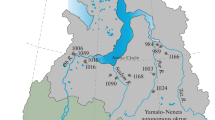Abstract
The composition of the water extracts, the pH, and the weight concentrations of the total organic carbon and low-molecular-weight organic acids in seasonally thawed and perennially frozen horizons of cryomorphic peat soils have been determined. The quantitative analysis of the acids converted to trimethylsilyl derivatives has been performed by gas chromatography and chromato-mass spectroscopy. Hydroxypropanoic, propanoic, and hydroxyethanoic acids are the prevailing acids (30–50, 10–20, and 10% of the total acids, respectively). Malic, glyceric, hexadionic, trihydroxybutanoic, ribonic, and other acids have also been detected. It has been shown that the differences in the genesis of the peat deposits significantly affect the composition and content of water-soluble organic compounds in soils on the soil-profile and landscape levels.
Similar content being viewed by others
References
L. N. Andreicheva and Yu. V. Golubeva, “Quaternary evolution of the environment and climate in the Arctic,” Vestn. Inst. Geol., Ross. Akad. Nauk, No. 4, 2 (2008).
Soil Atlas of the Komi Republic, Ed. by G. V. Dobrovol’skii, A. I. Taskaev, and I. V. Zaboeva (Komi Resp. Tipogr., Syktyvkar, 2010) [in Russian].
GOSTs (State Standards) 26423-85 and 26428-85: Soils. Methods of Analysis of Conductivity, pH, and Total Dissolved Solids in the Water Extract (Izd. Standartov, Moscow, 1985) [in Russian].
GOST (State Standard) R 52991-2008: Water. Methods of Analysis of the Total and Dissolved Organic Carbon (Standartinform, Moscow, 2009) [in Russian].
D. A. Kaverin and A. V. Pastukhov, “Genetic characteristics of barren circles on flat-topped peat mounds in the Bol’shezemel’skaya tundra,” Izv. Samar. Nauchn. Tsentra, Ross. Akad. Nauk 15(3), 55–62 (2013).
D. A. Kaverin, A. V. Pastukhov, and G. G. Mazhitova, “Temperature regime of tundra soils and underlying permafrost in the northeast of European Russia,” Kriosfera Zemli, 18(3), 23–32 (2014).
Classification and Diagnostic System of Russian Soils, Ed. by L. L. Shishov, V. D. Tonkonogov, I. I. Lebedeva, and M. I. Gerasimova (Oikumena, Smolensk, 2004) [in Russian].
L. N. Maksimova and E. N. Ospennikov, “Evolution of mire systems and permafrost of the Bolshezemelskaya tundra in the Holocene,” Kriosfera Zemli 16(3), 53–61 (2012).
G. V. Matyshak, Candidate’s Dissertation in Biology (Moscow, 2009).
A. B. Novakovskii, “A review of modern software tools to analyze geobotanical data,” Rastitel’nost’ Rossii, No. 9, 86–96 (2006).
G. G. Osadtchaya and N. V. Tumel’, “Local landscapes as indicators of geocryological zoning by the example of the European northeast,” Kriosfera Zemli 16(3), 62–71 (2012).
V. A. Popov, “Soils of peat mounds in the Extreme North,” in Materials on the Soils of the Komi ASSR: Soils of Plain and Mountainous and Their Fertility (Syktyvkar, 1974), pp. 10–16.
E. V. Shamrikova, Soil Acidity in Taiga and Tundra Areas in the European Northeast of Russia (Nauka, St. Petersburg, 2013) [in Russian].
E. V. Shamrikova, E. V. Vanchikova, T. S. Sytar’, and O. M. Zueva, “Comparison of the methods for determining the organic carbon concentration in natural waters and water extracts from soils,” Voda: Khim. Ekol., No. 4, 88–92 (2012).
E. V. Shamrikova, I. V. Gruzdev, V. V. Punegov, E. V. Vanchikova, and A. A. Vetoshkina, “Qualitative analysis of water extracts from podzols of the Komi Republic for the presence of organic compounds by mass spectroscopy,” Voda: Khim. Ekol., No. 11, 58–63 (2011).
E. V. Shamrikova, I. V. Gruzdev, V. V. Punegov, F. M. Khabibullina, and O. S. Kubik, “Water-soluble low-molecular-weight organic acids in automorphic loamy soils of the tundra and taiga zones,” Eurasian Soil Sci. 46(6), 654–659 (2013).
E. V. Shamrikova, O. S. Kubik, V. V. Punegov, and I. V. Gruzdev, “Effect of the biota diversity on the composition of low-molecular-weight water-soluble organic compounds in southern tundra soils,” Eurasian Soil Sci. 47(3), 173–181 (2014).
E. V. Shamrikova, V. V. Punegov, I. V. Gruzdev, and N. B. Aleksandrova, “Low-molecular-weight organic acids in the northern and extremely northern taiga of the Komi Republic,” Voda: Khim. Ekol., No. 11, 102–107 (2012).
E. V. Shamrikova, V. V. Punegov, I. V. Gruzdev, E. V. Vanchikova, and A. A. Vetoshkina, “Individual organic compounds in water extracts from podzolic soils of the Komi Republic,” Eurasian Soil Sci. 45(10), 939–946 (2012).
M. E. Marushchak, A. Pitkamaki, H. Koponen, C. Biasi, M. Seppala, and P. J. Martikainen, “Hot spots for nitrous oxide emissions found in different types of permafrost peatlands,” Gl. Change Biol. 17, 2601–2614 (2011).
A. Rodionow, H. Flessa, O. Kazansky, and G. Guggenberger, “Organic matter composition and potential trace gas production of permafrost soils in the forest tundra in northern Siberia,” Geoderma 135, 49–62 (2006).
J. Routh, H. Gustaf, P. Kuhry, T. Filley, P. K. Tillman, M. Becher, and P. M. Crill, “Multi-proxy study of soil organic matter dynamics in permafrost peat deposits reveal vulnerability to climate change in the European Russian Arctic,” Chem. Geol. 368, 104–117 (2014).
M. Schmid, M. S. Torn, S. Abiven, et al., “Persistence of soil organic matter as an ecosystem property,” Nature 478, 49–56 (2011).
M. Seppälä, “Surface abrasion of palsas by wind action in Finnish Lapland,” Geomorphology 52, 141–148 (2003).
World Reference Base for Soil Resources. A Framework for International Classification, Correlation, and Communication, World Soil Resources Reports no. 103 (FAO, Rome, 2006).
Author information
Authors and Affiliations
Corresponding author
Additional information
Original Russian Text © E.V. Shamrikova, D.A. Kaverin, A.V. Pastukhov, E.M. Lapteva, O.S. Kubik, V.V. Punegov, 2015, published in Pochvovedenie, 2015, No. 3, pp. 288–295.
Rights and permissions
About this article
Cite this article
Shamrikova, E.V., Kaverin, D.A., Pastukhov, A.V. et al. Water-soluble organic acids in cryomorphic peat soils of the southeastern Bol’shezemel’skaya tundra. Eurasian Soil Sc. 48, 250–256 (2015). https://doi.org/10.1134/S1064229315030102
Received:
Published:
Issue Date:
DOI: https://doi.org/10.1134/S1064229315030102




